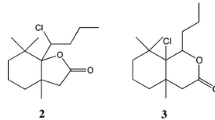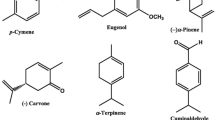Abstract
We isolated and identified (12Z,15Z)-1-acetoxy-2-hydroxy-4-oxoheneicosa-12,15-diene (persin) from avocado as a compound toxic to Spodoptera exigua larvae. Persin was obtained from oil extracted from the specialized idioblast cells of avocado fruit. When tested for activity using neonates in no-choice artificial diet bioassays, persin at concentrations of 200 μg/g inhibited growth; larvae gained only ∼50% of the weight attained by control insects after seven days. At concentrations of 400 μg/g or above, larval growth was reduced by >70% as measured by weight gain, and significant mortality occurred. In choice tests, persin at concentrations of 400 μg/g or higher deterred feeding, with significantly more larvae being found on control diet than on persin-treated diet. Possible applications of persin as a natural insecticide are discussed.
Similar content being viewed by others
REFERENCES
ANONYMOUS. 1980. Final report of the safety assessment for avocado oil. J. Environ. Pathol. Toxicol. 4:93–103.
ALKOFAHI, A., RUPPRECHT, J. K., ANDERSON, J. E., MC LAUGHLIN, J. L., MIKOLAJCZAK, K. L., and SCOTT, B. A. 1989. Search for new pesticides from higher plants, pp. 25–43, in J. T. Arnason, B. J. R. Philogene, and P. Morand (eds.). Insecticides of Plant Origin. ACS Symposium Series 387. American Chemical Society, Washington, DC.
BAAS, P., and GREGORY, M. 1985. A survey of oil cells in the dicotyledons with comments on their replacement by and joint occurrence with mucilage cells. Isr. J. Bot. 34:167–186.
BREWER, M. J., TRUMBLE, J. T., ALVARADO-RODRIGUEZ, B., and CHANEY, W. E. 1990. Beet armyworm (Lepidoptera: Noctuidae) adult and larval susceptibility to three insecticides in managed habitats and relationship to laboratory selection for resistance. J. Econ. Entomol. 83:2136–2146.
BREWER, M. J., MEADE, T., and TRUMBLE, J. T. 1995. Development of insecticide-resistant and-susceptible Spodoptera exigua (Lepidoptera: Noctuidae) exposed to furanocoumarins found in celery. Environ. Entomol. 24:392–401.
BULL, S. D., and CARMAN, R. M. 1994. Synthesis of the avocado antifungal, (Z, Z)-2-hydroxy-4-oxoheneicosa-12, 15-dien-1-yl acetate. Aust. J. Chem. 47:1661–1672.
CARMAN, R. M., and DUFFIELD, A. R. 1995. The isolation of (R)-2-hydroxy-4-oxoheneicosan-1-yl acetate from avocado leaves. Tetrahedron Lett. 36:2119–2120.
CHANG, C. F., ISOGAI, A., KAMIKADO, T., MURAKOSHI, S., SAKURAI, A., and TAMURA, S. 1975. Isolation and structure elucidation of growth inhibitors for silkworm larvae from avocado leaves. Agric. Biol. Chem. 39:1167–1168.
CUMMINGS, K., and SCHROEDER, C. A. 1942. Anatomy of the avocado fruit. Yearbook Calif. Avocado Soc. 1942:56–64.
DUKE, S. O. 1990. Natural pesticides from plants. pp. 511–517, in J. Janick, and J. E. Simon (eds.). Advances in New Crops. Proceedings of the First National Symposium on New Crops: Research, Development, Economics. Timber Press, Inc., Portland, OR.
FINNEY, D. J. 1971. Probit Analysis. Cambridge University Press, Cambridge, U.K.
HORTON, D. R. 1995. Statistical consideration in the design and analysis of paired-choice assays. Environ. Entomol. 24:179–192.
KOBILER, I., PRUSKY, D., MIDLAND, S., SIMS, J. J., and KEEN, N. T. 1993. Compartmentation of antifungal compounds in oil cells of avocado fruit mesocarp and its effect on susceptibility to Colletotrichum gloeosporioides. Physiol. Mol. Plant Pathol. 43:319–328.
MAC LEOD, J. K., and SCHAFFELER, L. 1995. A short enantioselective synthesis of a biologically active compound from Persea americana. J. Nat. Prod. 58:1270–1273.
MARIANI, P., CAPPELLETTI, E. M., CAMPOCCIA, D., and BALDAN, B. 1989. Oil cell ultrastructure and development in Liriodendron tulipifera L. Bot. Gaz. 150:391–396.
MARON, R., and FAHN, A. 1979. Ultrastructure and development of oil cells in Laurus nobilis L. leaves. Bot. J. Linn. Soc. 78:31–40.
MC KENZIE, H. L. 1935. Biology and Control of Avocado Insects and Mites. University of California, Berkeley Bulletin 592, 48 pp.
MINITAB. 1991. Minitab reference manual, No. 8. Minitab Statistical Software. State College, Pennsylvania.
MOAR, W. J., and TRUMBLE, J. T. 1987. Toxicity, joint action, and mean time of mortality of dipel 2X, avermectin B1, neem, and thuringiensin against beet armyworm (Lepidoptera: Noctuidae). J. Econ. Entomol. 80:588–592.
MURAKOSHI, S., ISOGAI, A., CHANG, C. F., KAMIKADO, T., SAKURAI, A., and TAMURA, S. 1976. Effects of two components from the avocado leaves (Persea americana Mill.) and the related compounds on the growth of silkworm larvae, Bombyx mori L. Jpn. J. Appl. Entomol. Zool. 20:87–91.
PATANA, R. 1969. Rearing cotton insects in the laboratory. U.S. Dep. Agric., Agric. Res. Serv., Prod. Res. Rep. 108:1–6.
PLATT, K. A., and THOMSON, W. W. 1992. Idioblast oil cells of avocado: distribution, isolation, ultrastructure, histochemistry, and biochemistry. Int. J. Plant Sci. 153:301–310.
POSTEK, M. T., and TUCKER, S. C. 1983. Ontogeny and ultrastructure of secretory oil cells in Magnolia grandiflora L. Bot. Gaz. 144:501–512.
PRABHAKER, N., COUDRIET, D. L., KISHABA, A. N., and MEYERDIRK, D. E. 1986. Laboratory evaluation of neem-seed extract against larvae of the cabbage looper and beet armyworm (Lepidoptera: Noctuidae). J. Econ. Entomol. 79:39–41.
PRUSKY, D., KEEN, N. T., SIMS, J. J., and MIDLAND, S. L. 1982. Possible involvement of an antifungal diene in the latency of Colletotrichum gloeosporioides on unripe avocado fruits. Phytopathology 72:1578–1582.
RODRIGUEZ-SAONA, C., and TRUMBLE, J. T. 1996. Toxicity, growth, and behavioral effects of an oil extracted from idioblast cells of the avocado fruit on the generalist herbivore beet armyworm (Lepidoptera: Noctuidae). J. Econ. Entomol. 89:1571–1576.
SEAWRIGHT, A. A., OELRICHS, P. B., NG, J. C., MACLEOD, J., WARD, A., SCHAFFELER, L., and CARMAN, R. M. 1995. Method of treatment of cancer as well as method of inhibition of lactation in mammals. Australian National University, Australia. Patent Coop. Treaty Int. Appl. No. WO 95/22969, 49 pp.
SMIRLE, M. J., and WEI, S. 1996. Effects of neem oil on feeding behavior and development of the pear sawfly, Caliroa cerasi. Entomol. Exp. Appl. 80:403–407.
SUPER ANOVA. 1989. Abacus Concepts Inc., Berkeley, California.
TRUMBLE, J. T. 1990. Vegetable insect control with minimal use of insecticides. Hortic. Sci. 25:159–164.
Author information
Authors and Affiliations
Rights and permissions
About this article
Cite this article
Rodriguez-Saona, C., Millar, J.G. & Trumble, J.T. Growth Inhibitory, Insecticidal, and Feeding Deterrent Effects of (12Z, 15Z)-1-Acetoxy-2-Hydroxy-4-Oxo-Heneicosa-12,15-Diene, a Compound from Avocado Fruit, to Spodoptera exigua . J Chem Ecol 23, 1819–1831 (1997). https://doi.org/10.1023/B:JOEC.0000006453.40940.a8
Issue Date:
DOI: https://doi.org/10.1023/B:JOEC.0000006453.40940.a8




